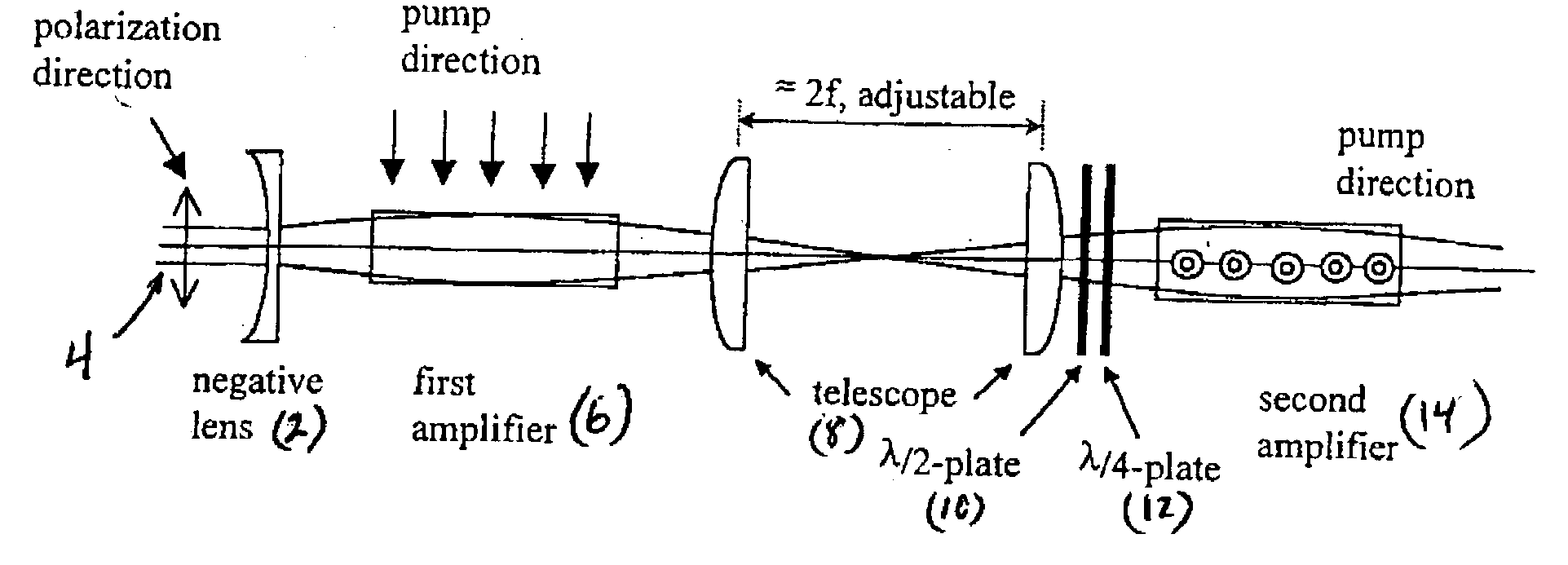[0045] To obtain high output power with high beam quality from a
solid state laser (such as Nd:YAG laser), an oscillator-amplifier setup is preferably employed in accordance with a preferred embodiment. The
master oscillator emits a TEM.sub.00 beam 4 with superior beam quality and high
degree of polarization, but with comparably low output power. This output is then amplified in one or more amplifier stages, e.g., stages 6 and 14 of FIG. 1. To maintain high beam quality, the beam is preferably not distorted in the amplifier stages 6, 14. The amplifiers 6, 14 are more sensitive to distortions in the laser
gain variations across the rod, because the beam passes only a single time through the laser rod, compared with multiple passes in the oscillator. Therefore, in the oscillator, the beam undergoes multiple steps of spatial filtering before it is output and thus acquires high
spatial quality.
[0047] FIG. 2 schematically illustrates a cross-sectional view of the preferred oscillator, and of a
pump chamber of a stage of the amplifier. The operation of this device is described in greater detail at the Ser. No. 09 / 938,329 application, incorporated by reference above. The preferred embodiment preferably uses pump chambers ("heads") 16 incorporating a single
diode array 18 (consisting typically of 3 bars) closely spaced to the
flow cell 20, which in turn comprises a diffuse reflector 22 and the laser rod 24. The preferred design has several advantages such as compactness, simplicity, and efficiency.
[0049] The preferred embodiments provide improved quality of the output beam by reducing the negative effects described in the background above. In applications such as micro-
machining, this permits the creation of higher quality and smaller size micro-features, and also the
processing of tougher materials at higher
throughput, because the higher-quality beam can be focused into a spot of smaller size and higher intensity.
[0060] In addition to the
fill factor, we found experimentally that the divergency of the beam in the rod is also important. There is an effect of the divergency on the quality of the output beam. The optimal divergency of the
incident beam is such that the output beam converges, as shown in FIG. 1. It is possible because the rod acts as a positive lens. Therefore, the
wavefront curvature
radius of the input beam is preferably adjusted to about twice the
focal length of this lens to make the output beam converge, with approximately a same degree as is the input divergence. The exact value of the focusing power of the amplifier stages and the divergence of the beam originating from the oscillator are not known precisely in general, because these parameters vary from laser to laser. To fill both amplifier stages perfectly, it is preferred to adjust 1) divergency and
diameter of the beam at the entrance of the first amplifier stage, and 2) same beam parameters in between the amplifier stages. The negative lens 2 (see FIG. 1) in front of the first stage allows an increase of the divergency of the beam. In order to adjust the
beam diameter, one can adjust the distance between the lens 2 and the first stage 6. An additional benefit of this optimal mode
size matching is that these rods also act as apertures, thus defining the circularity of the beam.
[0062] As is discussed above, the pump light can induce stress in the laser rod, which, can in turn, lead to induced
birefringence. This means that the
linearly polarized light may undergo some
depolarization, whose magnitude depends on the position in the rod. The locations on the axes X and Y (see FIG. 3) do not introduce any
depolarization, while the areas around 45.degree., 135.degree., 225.degree., 315.degree. produce an elliptically polarized beam at the output, instead of a linearly polarized one. The total
depolarization of the entire amplifier can be reduced by placing an additional .
lambda. / 4-plate 12 in between the stages 6,14, with its
optical axis oriented at 0.degree. to either the X or Y axis.
Linearly polarized light will not be affected by this plate, but depolarized light from the areas at 45 degrees will receive a quarter-wave phase shift between the fast and slow components. This effectively makes the fast component from the first stage 6 to become a slow component in the second stage 14, and vice versa. Therefore, a phase shift that occurred in the first stage 6 is compensated for in the second stage 14. Alternatively, a
quartz rotator (not shown) can be used in place of both the .
lambda. / 4 plate 12 and .
lambda. / 2 plate 10. An
advantage here is that there are fewer optical components. However, use of a
quartz rotator may increase the cost of the
system.
 Login to View More
Login to View More  Login to View More
Login to View More 


